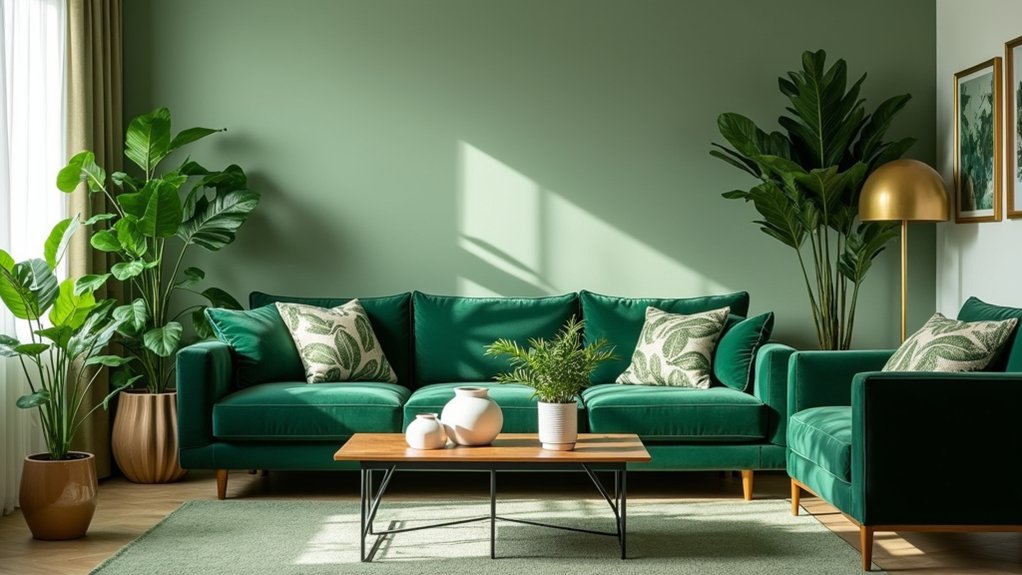
16 Green Aesthetic Living Room Ideas That Are Serene and Trendy
A green aesthetic living room weaves serene pastel greens, lush indoor plants, and biophilic design for a tranquil, trend-forward atmosphere. Layered green hues—ranging from pale mint to deep forest—enhance depth and maximize light. Natural textures, such as rattan, linen, and wood, introduce sophisticated warmth and visual interest. Clean lines, minimalist shapes, and curated plant arrangements support both Scandinavian calm and retro sensibilities. Discover how colour-blocking, statement furnishings, and innovative accessorizing uplift these serene, modern green spaces.
Key Takeaways
- Layer pastel greens with modest black accents for a serene, visually cohesive living room that maximizes light and depth.
- Incorporate lush indoor plants like fiddle leaf figs and snake plants to reinforce the green aesthetic and promote biophilic serenity.
- Mix natural wood finishes, rattan, and linen textures to add warmth and dimensionality to green-centric interiors.
- Use deep forest green feature walls or plush green sofas as statement pieces, paired with neutral or earthy tones for balance.
- Accessorize with decorative planters, botanical patterns, and monochrome green palettes to create a tranquil yet trendy living space.
Light and Airy Green Spaces
By anchoring the space with a crisp white palette, light and airy green living rooms enhance the vibrancy of verdant accents for a fresh, contemporary effect. Designers frequently deploy light green paint on walls to evoke tranquility and maximize luminosity, serving as a subtle backdrop for curated color layering. A green velvet sofa, both tactile and on-trend, introduces a focal point that balances sophistication with comfort. Blonde wood furniture and brass fixtures infuse warmth and tactile contrast, elevating the serene ambiance. Expansive windows, paired with minimalistic window treatments, amplify natural light, allowing every green hue to resonate. Layering gradients of green—through cushions, textiles, and artwork—generates visual dimension, ensuring cohesion. This approach yields spaces that are both tranquil retreats and style-forward interiors. To enhance the overall aesthetic, metallic lighting fixtures with warm brass finishes can be utilized, adding an elegant touch to the living room decor.
Botanical-Inspired Decor
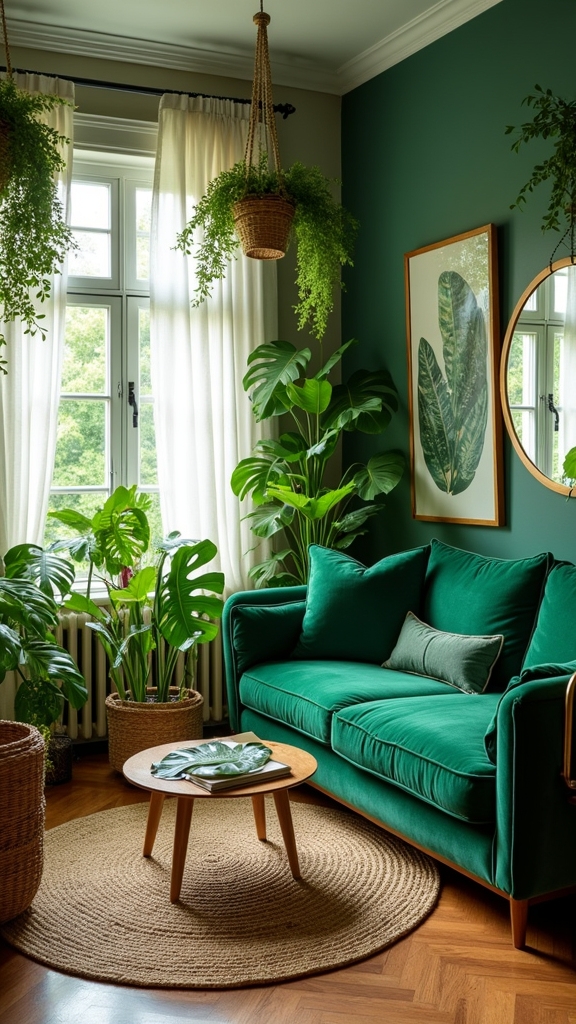
Botanical-inspired decor harnesses the visual impact of layered green hues, lush indoor foliage, and organic textures to establish a restorative living space.
Strategic placement of verdant plants alongside botanical patterns and tactile materials such as rattan or linen creates a multidimensional, biophilic environment.
This approach, increasingly favored in contemporary interiors, celebrates the interplay between nature and design for a harmonious, on-trend aesthetic.
Integrating low-maintenance plants like Pothos, Monstera Deliciosa, and English Ivy enhances air quality and adds a natural elegance, making them ideal choices for living room decor.
Layering Natural Green Hues
While subtle shifts in color can dramatically influence interior mood, layering natural green hues establishes a calming foundation for botanical-inspired living rooms.
Designers recommend integrating an array of green shades—ranging from muted sage to deep forest tones—to create nuanced visual depth and evoke biophilic serenity.
Statements such as a velvet sofa in olive or emerald paired with earthy accents like jute rugs and wooden furnishings contribute to a cohesive, nature-centric palette.
Employing textured wall finishes in green, whether matte or glossy, further enhances dimensionality and reinforces the organic theme.
This approach aligns with contemporary trends that prioritize tranquil, restorative spaces through color psychology.
Incorporating Lush Indoor Plants
Extending the verdant palette beyond walls and furnishings, the strategic introduction of lush indoor plants reinforces the green aesthetic while directly enhancing air quality and psychological comfort.
Expertly curated selections such as fiddle leaf figs, snake plants, and pothos are frequently favored for their robust adaptability and sculptural foliage, blending resilience with visual impact.
Utilizing decorative planters and raised stands not only accentuates architectural interest but also allows indoor plants to act as curated focal points within the living room.
Layering specimens of varying heights and species introduces dynamic depth, amplifying a sense of biophilic design.
Integrating options like peace lilies and spider plants strengthens the connection to nature, positioning indoor plants as both functional and trend-forward elements in serene, green-inspired living spaces.
Botanical Patterns and Textures
Through the deliberate integration of botanical patterns and varied textures, a living room’s green aesthetic is enhanced from mere color selection to a multisensory experience.
Botanical patterns in textiles—such as cushions, curtains, and leaf-patterned rugs—infuse the space with organic vibrancy, while textured wall finishes like grass cloth or botanical-themed wallpaper introduce tactile sophistication and visual depth.
Accessorizing with potted plants and botanical prints extends the verdant motif, cultivating a tranquil, biophilic ambiance.
Layering diverse green hues and textures, from woven materials to leafy motifs, achieves a cohesive, garden-inspired environment that feels both curated and restorative.
Selecting furniture crafted from natural materials—rattan or reclaimed wood—further complements botanical patterns, reinforcing the eco-friendly ethos and contemporary relevance of nature-inspired living room design.
Saturated Colour and Ceiling Paint Tricks
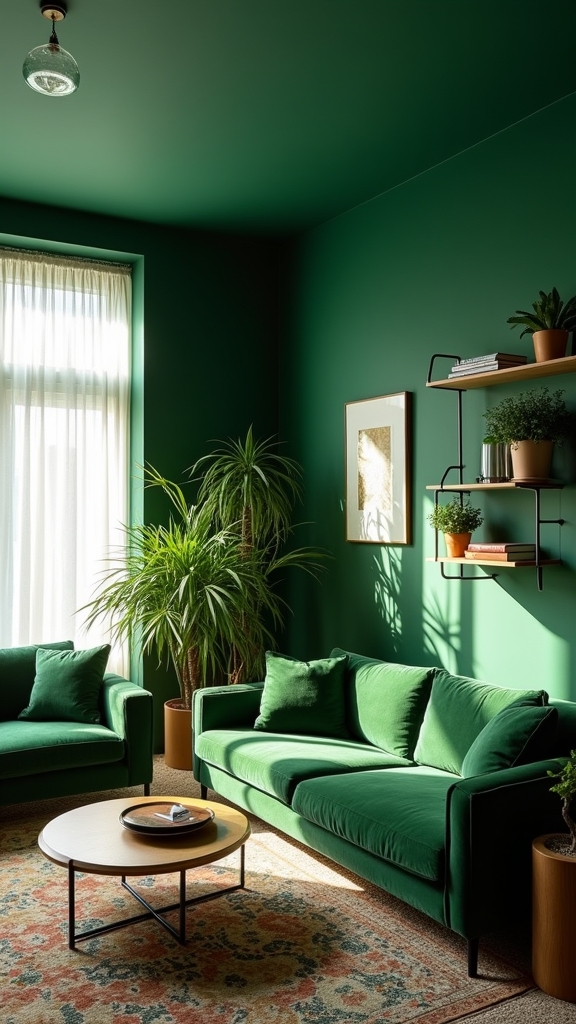
Confident decorators’ affinity for saturated green hues—ranging from lush emerald to deep forest—anchors a living room in bold, contemporary style, instantly commanding attention.
Utilizing saturated colour as a design statement, these experts employ ceiling paint tricks to enhance spatial perception and atmosphere. Glossy finishes on ceilings amplify ambient light, accentuating the depth and vibrancy of rich greens.
Colour drenching, the strategic application of the same saturated hue across walls and ceilings, creates a seamless, immersive environment, unifying disparate architectural elements. For those seeking intimacy in expansive spaces, darker ceiling tones lend sophistication and a cocooning effect. Additionally, incorporating textured accessories like velvet pillows can add warmth and complement the green aesthetic.
- Use glossy ceiling paints to reflect light and intensify saturated colour depth.
- Employ colour drenching for a cohesive, all-encompassing visual impact.
- Opt for dark ceiling hues to create a sophisticated, intimate living area.
Embracing Pastel Greens
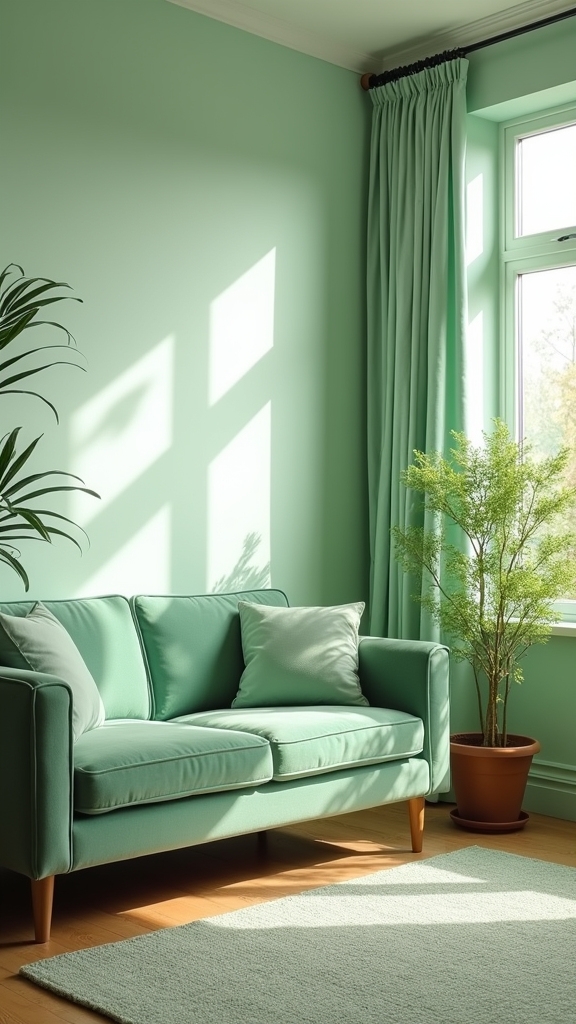
Embracing pastel greens introduces a soft color palette that fosters tranquility and visual spaciousness in modern living rooms.
When paired with understated neutrals, these gentle hues balance contemporary aesthetics with a subtle sophistication.
Utilizing their reflective qualities, pastel greens maximize natural light, resulting in a luminous and inviting environment.
Soft Pastel Color Palettes
Pastel green, a cornerstone of contemporary green aesthetics, introduces a tranquil foundation to living room design.
Soft pastel greens are favored for their ability to evoke serenity and visual spaciousness, making them especially suited for rooms intended for relaxation.
Expert designers leverage these delicate hues to create sophisticated, calming environments that align with current interior trends.
By integrating soft pastel greens, the living area feels both refreshed and timelessly inviting.
Subtle black accents can be introduced for minimalistic contrast, ensuring the palette remains gentle yet visually dynamic.
- Walls in soft pastel greens amplify natural light, fostering a serene and airy ambiance.
- Pastel green furnishings—such as an upholstered sofa or accent chair—add a revitalizing, on-trend touch.
- Artful decor pieces in pastel green create cohesion and subtle visual interest throughout the space.
Pairing Pastels With Neutrals
A harmonious juxtaposition of soft greens and neutral hues defines the essence of a refined green aesthetic living room. Embracing pastel greens as core elements of Green Decor introduces a tranquil and restorative ambiance, ideal for contemporary serenity.
When paired with whites, creams, or light grays, pastel greens form a balanced and cohesive palette, ensuring visual continuity without overpowering the space. Expertly curated accent pieces—such as pastel green cushions, vases, or wall art—offer subtle chromatic interest, while maintaining an understated sophistication.
For added dimension, modest black accents can be strategically integrated to create visual contrast, enriching the layered aesthetic. This nuanced interplay aligns with current interior design trends, promoting relaxation and versatility while upholding a distinctly modern green aesthetic.
Enhancing Light and Airiness
How can a living room achieve a sense of effortless openness and tranquility? The answer lies in the strategic use of pastel greens, which introduce a serene, rejuvenating ambiance while maximizing light and airiness.
Pastel greens, when expertly layered, enhance spatial perception, brighten compact interiors, and uplift the aesthetic with a contemporary edge. This chromatic palette invites a calming presence, especially when juxtaposed with subtle black accents for visual depth and modernity.
- Walls in pastel greens reflect natural light, visually expanding the room and fostering an inviting environment.
- Upholstered furnishings—sofas and armchairs in pastel greens—create cohesion and amplify the airy effect.
- Accessories such as vases, cushions, and throws in varying shades of pastel green curate a harmonious, trend-forward living space.
Creating a Bold WFH Corner
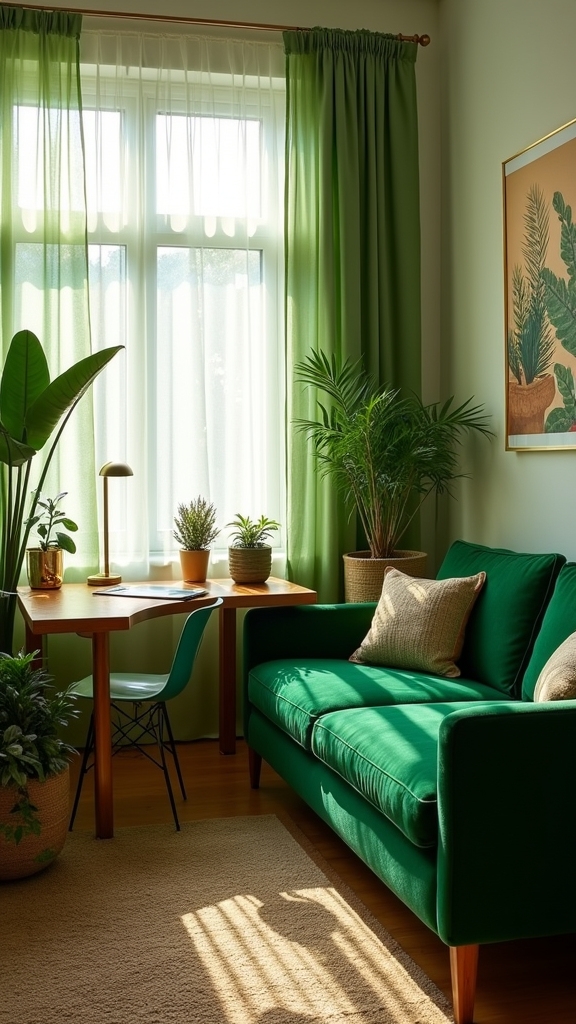
Why not invigorate the work-from-home experience with a bold infusion of deep forest green? This sophisticated shade, when used as a feature wall or in select green accents, establishes a visually commanding yet serene workspace. Ergonomic furniture—think contoured chairs and modular desks—anchors comfort and focus, while lush indoor plants function as both biophilic design elements and air quality enhancers. Harnessing natural light, whether via expansive windows or reflective surfaces, amplifies the environment’s vibrancy and bolsters cognitive performance. Strategic placement of artwork or personalized décor injects individuality, transforming the WFH corner into an inspiring productivity hub. This approach aligns with current interior trends that champion bold color plays and wellness-driven design, making the workspace both aesthetically compelling and functionally dynamic. To create a truly cozy atmosphere, consider adding plush rugs like shaggy or wool for comfort and warmth.
Mixing Green With Patterns
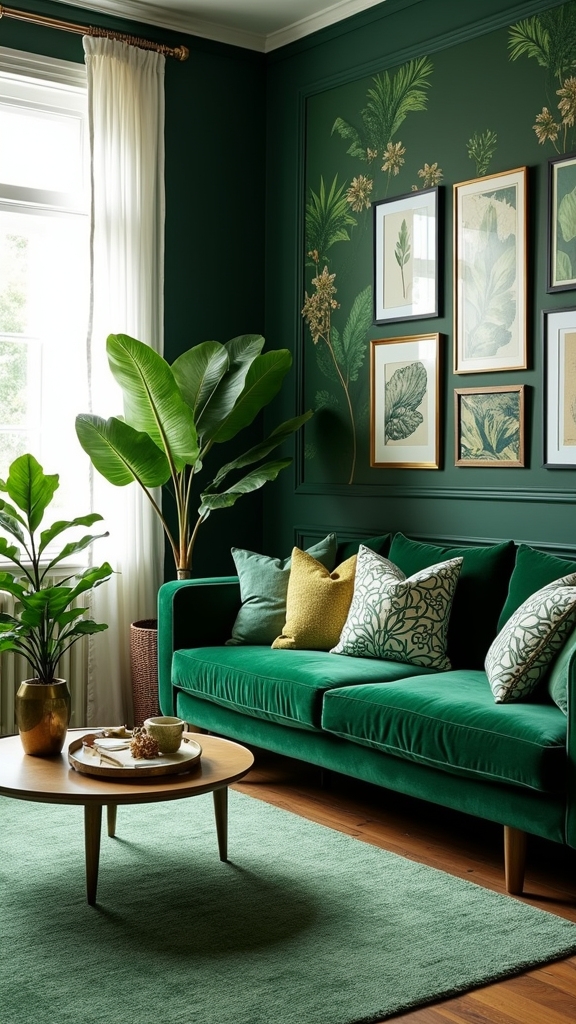
Pairing bold patterns with vibrant green tones introduces a layered visual narrative, central to current maximalist design trends. Contrasting textures and prints—such as geometric rugs or botanical wallpapers—break up monotony and amplify spatial depth. Strategic use of patterned accessories and greenery guarantees both cohesion and a dynamic, nature-inspired ambiance. A consistent color palette with complementary hues not only enhances the mood but also promotes visual harmony within the space.
Bold Patterns, Vibrant Green
When layered with bold patterns, vibrant green hues transform a living room into a visually stimulating environment that exemplifies contemporary design sensibilities.
Designers frequently deploy vibrant green as a chromatic anchor, utilizing its energetic presence to amplify patterned textiles and accent pieces. Whether geometric or botanical, patterns interwoven with green tones introduce visual rhythm and spatial depth, countering the monotony of solid color palettes.
Strategic layering of green shades with contrasting motifs opens up compact living areas, rendering them more expansive and inviting. Patterned wallpapers featuring green motifs further establish cohesion, allowing furnishings and artwork to harmonize seamlessly.
- Geometric cushions in vibrant green paired with floral rugs, producing dynamic visual tension.
- Patterned green wallpaper as a backdrop, integrating cohesive design elements.
- Artwork and throws featuring green accents, enriching overall aesthetic harmony.
Contrasting Textures and Prints
Although green is traditionally associated with tranquility, its application alongside contrasting textures and prints introduces a sophisticated interplay that enhances the living room’s visual narrative.
Expertly curated interiors now showcase bold green hues juxtaposed with dynamic patterns—floral, geometric, even polka dots—resulting in a visually compelling yet serene environment.
The integration of patterned accessories, such as throw pillows or area rugs in varying shades of green, not only unifies the design but also adds tactile depth.
A plush green velvet sofa, when paired with woven materials or patterned textiles, demonstrates how contrasting textures boost richness and sensory appeal.
This strategic mix of texture and print reflects a current trend: layering for depth and vibrancy, while maintaining the calming essence fundamental to green aesthetic living rooms.
Scandinavian Style Green Living Rooms

Distinguished by its reverence for minimalism and natural light, Scandinavian style green living rooms integrate pale green hues with timeless neutrals to cultivate a tranquil, airy ambiance.
This approach to green living room ideas employs a sophisticated palette, where soft biscuit tones and warming creams harmonize with delicate green accents.
Lightweight furniture, characterized by clean lines, guarantees that spaces remain uncluttered and visually expansive.
Oversized indoor plants are strategically positioned to reinforce the biophilic connection, while subtle green elements anchor the room in calming serenity.
The interplay of muted colors and botanical motifs defines this trend-forward aesthetic.
- Pale green textiles layered with cream and biscuit-hued upholstery.
- Streamlined, minimalist seating paired with sculptural, oversized potted plants.
- Subtle green accents complementing a backdrop of timeless neutral walls.
Incorporating Wood Tones and Natural Textures
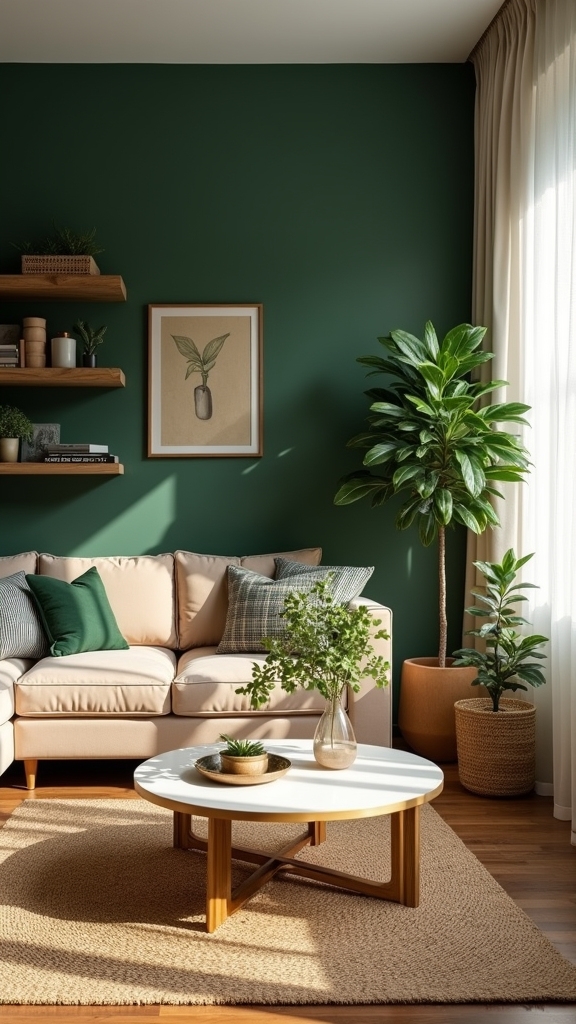
Layering wood tones alongside green hues anchors the living room in biophilic design principles, fostering both warmth and tranquility.
Expertly mixing textures—such as pairing rattan and linen with polished or matte wood finishes—brings dimensionality and tactile interest to the space.
This approach reflects current trends that favor organic materials and thoughtfully curated material contrasts.
Layering Wood and Green
A harmonious interplay of wood tones and green hues defines the foundation of a modern biophilic living room. Incorporating green walls with complementary wood elements enhances the visual narrative, blending nature-inspired sophistication with warmth.
Expertly layered, natural wood finishes—whether blonde, walnut, or oak—provide contrast against verdant shades, enhancing depth and vibrancy. The juxtaposition of these organic materials not only amplifies daylight but also infuses the space with tranquility and tactile intrigue.
- Green Walls and Wood Paneling: Pair lush green walls with vertical or horizontal wood paneling to maximize light diffusion and create a serene, enveloping atmosphere.
- Mixed Wood Furnishings: Blend mismatched wooden tables and shelving to introduce visual dynamism while grounding green decor.
- Natural Accents: Integrate rattan or wicker accessories for a seamless, multi-textured biophilic ambiance.
Mixing Textures Creatively
Texture becomes the linchpin of a truly immersive green aesthetic living room, where the interplay of wood tones and organic materials shapes both visual and tactile appeal.
A green velvet sofa, with its plush, lustrous surface, anchors the space while inviting contrast from light blonde oak or rich walnut furnishings. The inclusion of shiplap or reclaimed wood wall finishes introduces dimensionality, enhancing the verdant hues of green walls.
Layered natural elements—wicker baskets, jute rugs, cotton, and linen textiles—amplify the environment’s serenity and tactile richness. Thoughtful juxtaposition of tall plants and low-profile seating fosters a dynamic composition, while decorative wooden vases or candle holders reinforce cohesion.
This curated blend of textures and finishes encapsulates a contemporary, tranquil green living room reflective of current biophilic design trends.
Playing With Different Heights in Decor
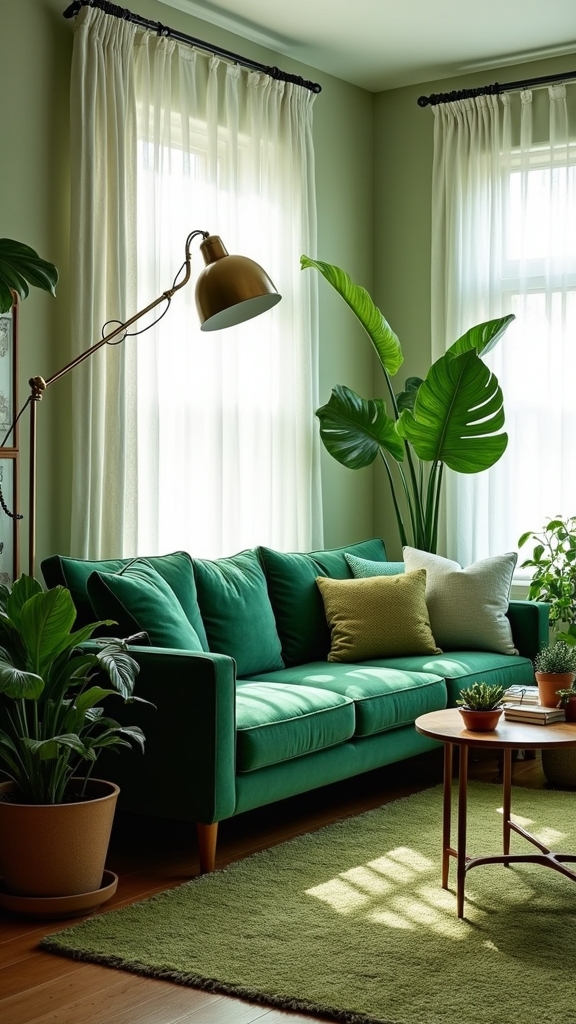
Elevating the visual narrative of a green aesthetic living room, playing with decor at varied heights introduces dynamic contrast and depth. Expert designers leverage this approach to break the monotony often found in compact spaces, utilizing dimensional layering to maximize both serenity and visual intrigue. A green aesthetic thrives when tall, lush plants juxtapose low-profile sofas, and when a curated mix of shelves and wall-mounted décor provides intentional elevation. This practice accentuates green accents, guiding the observer’s gaze upward and throughout the space. For a contemporary, engaging environment, consider the following: 1. Floor-to-ceiling plants paired with minimalist, low-slung seating. 2. Staggered wall shelving and art installations highlighting verdant hues. 3. Groupings of candle holders and vases at varying heights to create sculptural focal points. The use of natural materials and houseplants not only complements the green aesthetic but also enhances the overall calming ambiance of the room.
Retro Green Colour Schemes
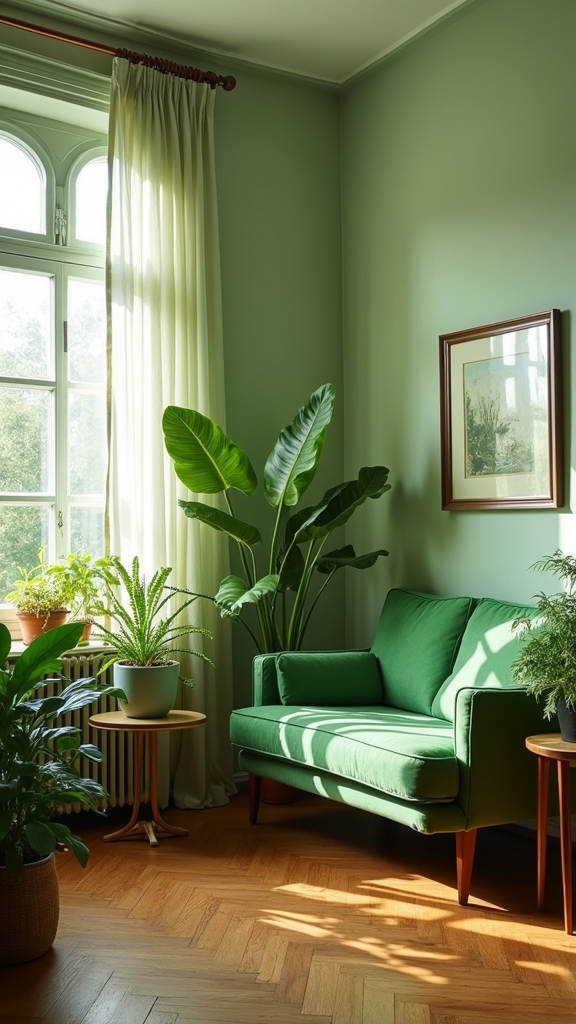
Nostalgic yet undeniably current, retro green colour schemes channel the visual richness of mid-century and 70s design by blending deep moss and forest greens with earthy terracotta, warm pinks, and reddish browns.
In a Dark Green Living Room, these palettes evoke warmth and sophistication, utilizing saturated hues to create an enveloping atmosphere. Incorporating Room Green through floor-to-ceiling curtains or a vintage green velvet sofa introduces both drama and tactile luxury, highlighting ceiling height and architectural features.
Patterned textiles, such as geometric or floral prints, amplify the maximalist spirit, while terracotta accents ground the aesthetic in retro authenticity. Expertly curated, the interplay of green tones with vintage furniture encapsulates the essence of retro revival, proving both visually engaging and unmistakably on-trend for contemporary interiors.
Adding natural materials like wood elements and stone features enhances the rustic charm, creating a serene yet trendy living space.
Light and Bright Green Accents
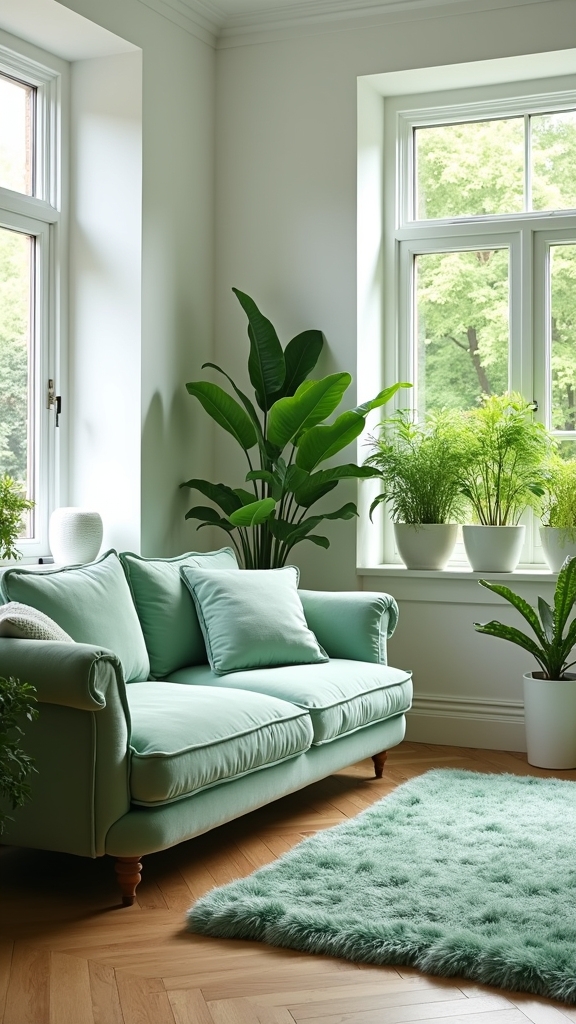
While retro palettes celebrate the depth and drama of saturated greens, light and bright green accents offer an equally nuanced approach to colour, emphasizing tranquility and luminosity.
Integrating soft pastel hues—think mint or sage—infuses living spaces with a calming ambiance, supporting relaxation and rejuvenation.
Expert designers recommend pairing crisp white walls with light green accents, such as throw pillows or curated artwork, to achieve a fresh, airy aesthetic suitable for contemporary and evolving decor.
The intersection of organic light wood furniture and bright green accents introduces warmth while maintaining visual equilibrium.
Layering tactile textures—like a light green velvet sofa juxtaposed with neutral textiles—adds sophisticated depth and spatial dimension, ensuring the room feels both serene and visually engaging.
Incorporating warm greens like forest green enhances coziness and connects the space to nature, transforming the living room into a tranquil haven.
- Mint or sage pastel accessories
- Light green velvet seating with neutrals
- White walls and light wood pairings
Monochrome Green and Black-White Palettes
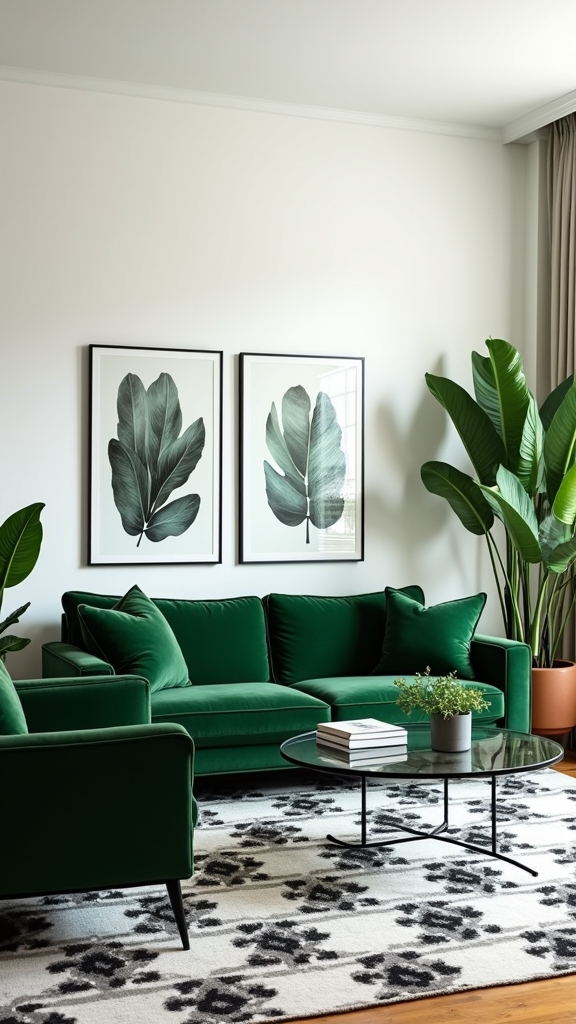
Monochrome sophistication defines the green and black-white palette, where varying shades of green—ranging from muted sage to rich forest—are strategically layered to craft a serene yet visually dynamic living room. This monochrome green approach, juxtaposed with crisp black and white elements, yields a high-contrast, trend-forward space that feels cohesive yet lively. Texture plays a pivotal role: velvet furnishings, matte painted walls, and tactile accessories enhance visual interest while retaining tranquility. Strategic placement of black and white accent pieces—throw pillows, geometric rugs, or minimalist art—breaks up the green, preventing monotony. Natural materials and lush plants further ground the design, reinforcing a calming biophilic connection. Neutral color palettes create a calming ambiance and allow for experimentation with textures and materials for added depth.
| Velvet Sofa | Matte Green Walls | Black-White Artwork |
|---|---|---|
| Sage Throw Pillows | Forest Area Rug | Marble Coffee Table |
| Glossy Ceramics | Potted Plants | Monochrome Prints |
| Woven Textures | Minimalist Lighting | White Sheer Drapes |
| Black Metal Frame | Pastel Accessories | Contrast Cushions |
Rethinking Cabinetry With Green Hues
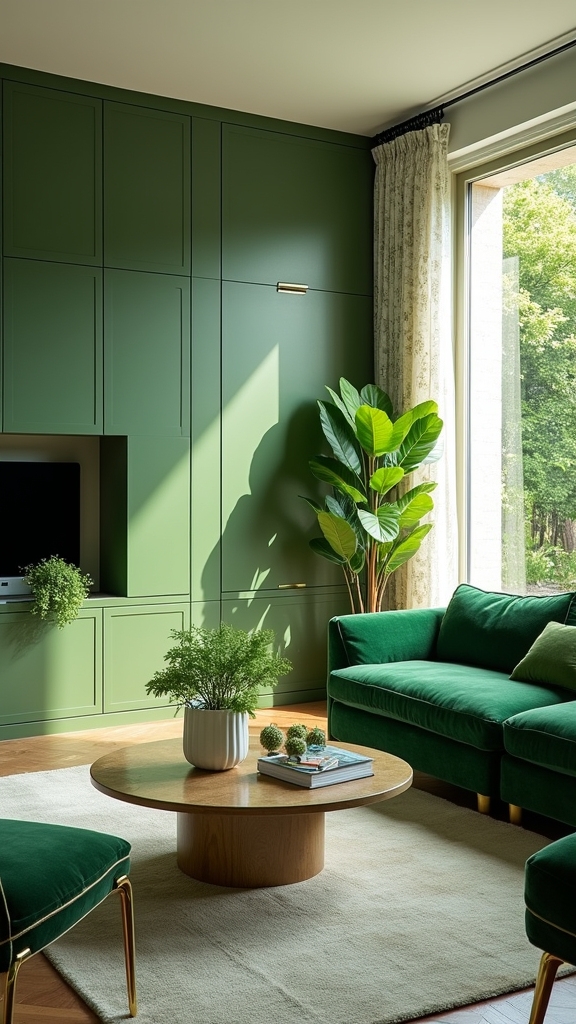
By integrating cabinetry in nuanced green hues, a living room immediately gains an enhanced sense of depth and contemporary character.
Green cabinetry introduces a refined, nature-inspired palette that aligns with biophilic design trends, fostering tranquility and grounding the space visually.
Deep tones like olive and emerald create sophisticated contrast against pale countertops or open shelving, drawing attention to architectural features while maintaining cohesion.
The use of green cabinetry is also a conscious nod to sustainability, especially when paired with eco-friendly materials, reflecting a commitment to environmentally responsible interiors.
- Layered Greens: Combine various green shades within cabinetry for visual complexity and a multidimensional effect.
- Contrasting Elements: Pair deep green cabinetry with light surfaces for modern juxtaposition and heightened impact.
- Sustainable Materials: Opt for green cabinetry constructed from reclaimed or responsibly sourced woods for trend-forward eco-appeal.
Colourful Home Office Corners
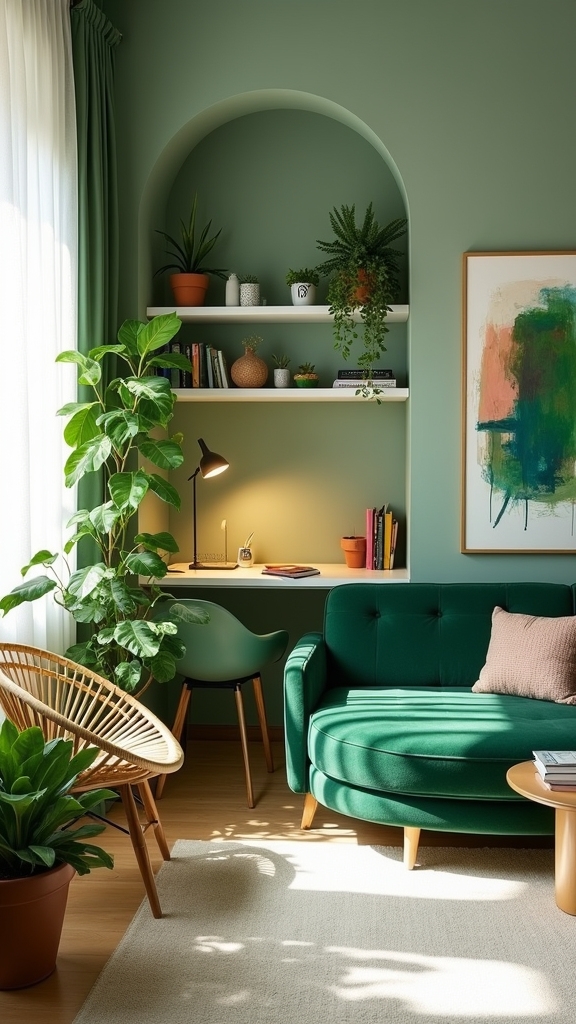
Extending the influence of green beyond cabinetry, home office corners are emerging as dynamic focal points within the living room, where a curated interplay of colour and function enhances productivity.
Deep forest green, when applied to accent walls or bespoke shelving, enlivens the workspace, stimulating creativity and mental clarity. Designers are integrating ergonomic chairs in vibrant hues, offering both visual excitement and enduring comfort for extended work sessions.
Layered shelving at varying heights introduces architectural rhythm, supporting organization without sacrificing aesthetic cohesion. Strategic placement of indoor plants further punctuates the green palette, simultaneously revitalizing the air and reinforcing a serene, biophilic atmosphere.
Personalized artwork and green-inspired decor articulate individual style, fostering motivation within a thoughtfully designed, colour-forward environment that raises both productivity and visual harmony. Consider artificial lighting if natural light is insufficient to maintain plant health, ensuring your indoor garden thrives even in dimly lit spaces.
Embracing Nature and Sustainable Materials
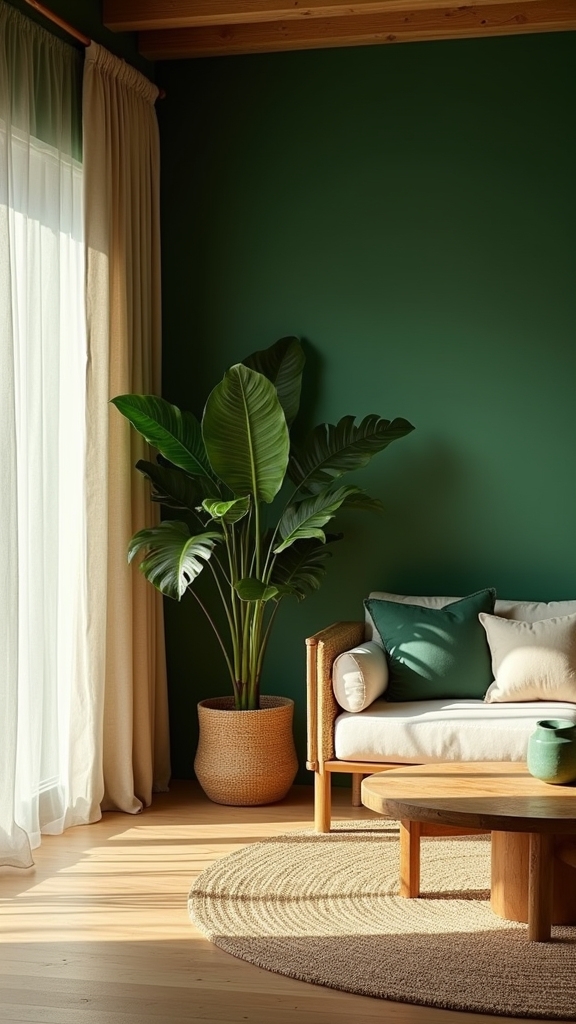
While contemporary design trends evolve, the integration of natural elements and sustainable materials remains a cornerstone of green aesthetic living rooms.
Designers are increasingly utilizing biophilic principles and eco-conscious resources to craft interiors that feel both tranquil and current. Emphasizing a harmonious relationship with nature, these spaces utilize organic textures and materials that reduce environmental impact without compromising style.
Earthy color palettes, especially when anchored by a statement green sofa, foster a soothing ambiance. Eco-friendly paints and natural finishes further enhance indoor air quality and visual cohesion. The result is a living environment that is both environmentally responsible and visually compelling.
- Reclaimed wood coffee tables paired with bamboo shelving for layered organic texture.
- A plush green sofa set against walls finished with low-VOC, eco-friendly paint.
- Organic cotton or linen textiles in muted earth tones.
Accessorizing With Greenery and Plants
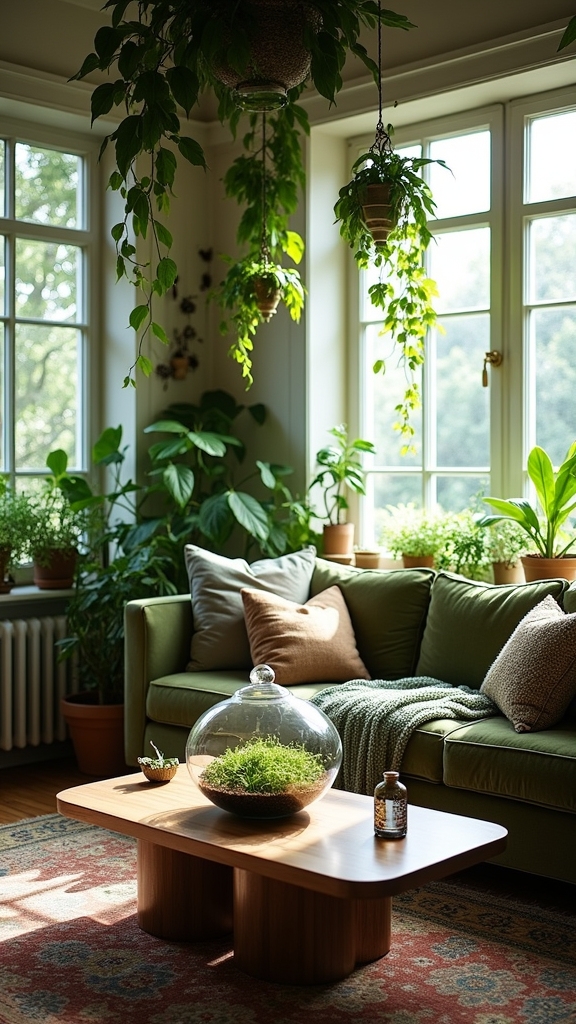
How can a living room achieve both energy and tranquility? Strategic accessorizing with greenery and plants achieves this duality, introducing visual vibrancy while fostering a serene ambiance. Experts recommend layering a variety of plant species—think tall fiddle-leaf figs paired with compact succulents—to establish depth and a lush, immersive aesthetic. The selection of planters is equally significant; terracotta, ceramics, or woven baskets synchronize with green tones and enhance the overall scheme. For spatial efficiency and a modern touch, hanging plants or wall-mounted planters add a dynamic vertical component. Regular rotation of greenery and seasonal blooms refreshes the space, ensuring ongoing engagement and trend relevance.
| Plant Type | Recommended Placement |
|---|---|
| Tall Floor Plants | Corners, beside sofas |
| Small Succulents | Coffee tables, shelves |
| Hanging Plants | Windows, ceiling hooks |
| Wall-Mounted Planters | Accent walls, entryways |
Frequently Asked Questions
How Do I Choose the Right Shade of Green for My Living Room Walls?
Selecting the ideal shade of green for living room walls involves evaluating natural light, desired ambiance, and current trends. Color psychology suggests soft sage for tranquility or rich emerald for sophistication, ensuring harmony with existing furnishings and decor elements.
Can Green Aesthetics Work in Small or Dimly Lit Living Rooms?
In small spaces or dimly lit living rooms, green aesthetics can visually expand the area and introduce tranquility. Opting for lighter, reflective green tones enhances luminosity, while strategic accent placement keeps the design modern and trend-conscious.
What Are Some Affordable Ways to Add Green Accents Without Repainting?
Affordable green accents can be achieved through botanical throw pillows, verdant area rugs, and art featuring foliage motifs. Incorporating natural textures—such as woven baskets or linen drapes—adds dimension, while trending faux plants enhance visual interest without requiring repainting.
How Can I Balance Green Decor With Existing Non-Green Furniture?
Achieving color harmony involves layering green decor through curated textiles, botanicals, and statement art, ensuring undertones complement existing furniture. Strategic placement and trending mixed-material accents visually bridge disparate hues, fostering a cohesive, contemporary living environment.
Are There Specific Lighting Types That Enhance Green Tones in a Room?
When evaluating Lighting Options to enhance green tones, experts recommend adjustable LED fixtures with a high Color Rendering Index (CRI) and warm white bulbs. These options visually amplify green hues, aligning with contemporary trends in atmospheric, color-conscious interior design.
Conclusion
Incorporating green into living room design remains an on-trend strategy for cultivating serenity and visual intrigue. From botanical motifs and sustainable textures to bold saturated tones and nuanced pastel palettes, green offers remarkable versatility. Whether through cabinetry, accent walls, or biophilic accessories, these approaches seamlessly merge aesthetic sophistication with wellness principles. As interiors continue to embrace nature-inspired palettes, the green living room emerges as a benchmark for both contemporary style and mindful, calming environments.
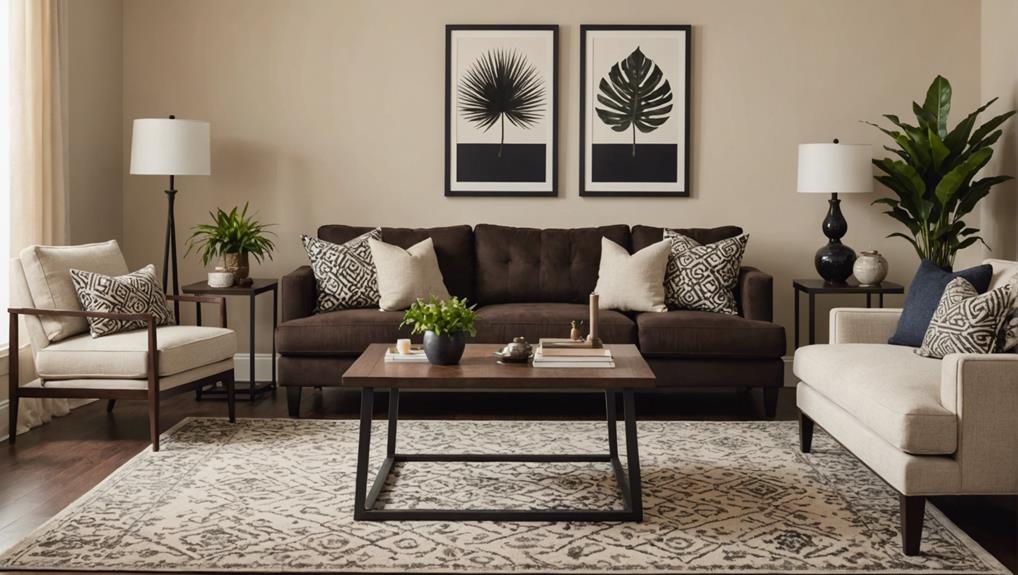
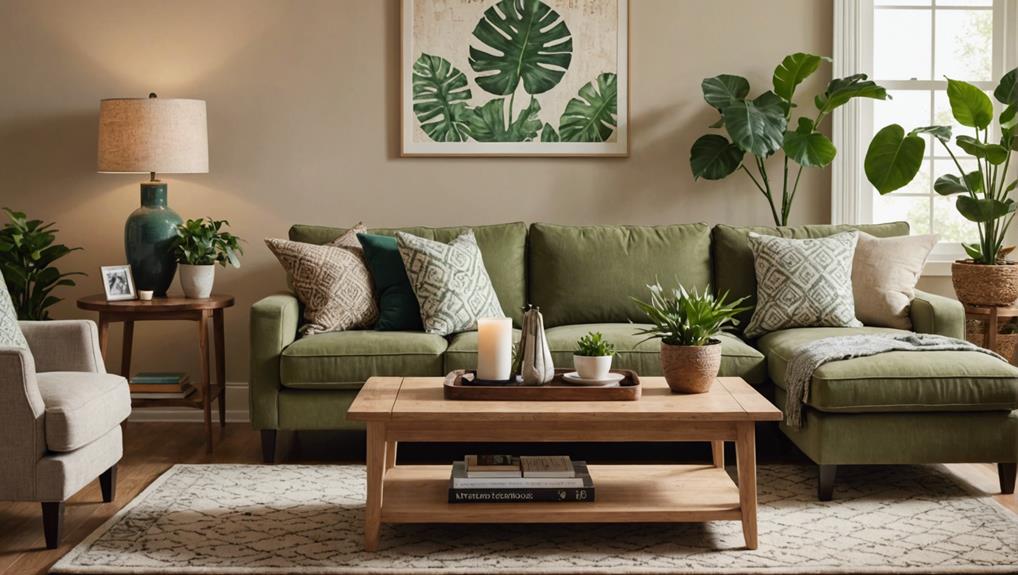
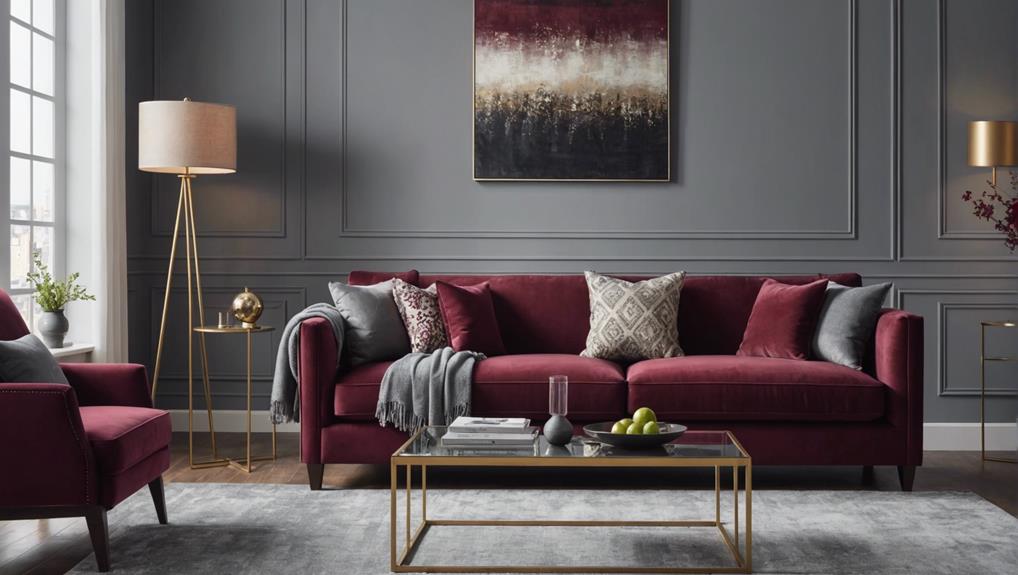
Leave a Reply